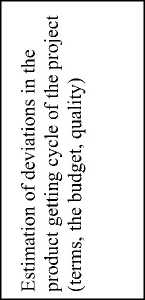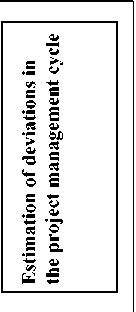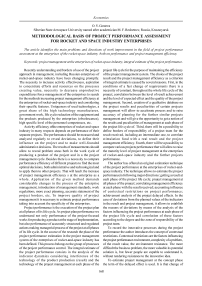Methodological basis of project performance assessment for rocket and space industry enterprises
Автор: Gosteva O.V.
Журнал: Сибирский аэрокосмический журнал @vestnik-sibsau
Рубрика: Экономика
Статья в выпуске: 5 (26), 2009 года.
Бесплатный доступ
The article identifies the main problems and directions of work improvement in the field of project performance assessment at the enterprises of the rocket-space industry, both on performance and project management efficiency.
Project management at the enterprises of rocket-space industry, integral estimate of the project performance
Короткий адрес: https://sciup.org/148176082
IDR: 148176082
Текст научной статьи Methodological basis of project performance assessment for rocket and space industry enterprises
Recently understanding and borders of use of the project approach in management, including Russian enterprises of rocket-and-space industry have been changing promptly. The necessity to increase activity effectiveness, aspiration to concentrate efforts and resources on the processes creating value, necessity to decrease unproductive expenditures force management of the enterprises to search for the methods increasing project management efficiency at the enterprises of rocket-and-space industry and considering their specific features. Uniqueness of used technologies, a great share of the high technology manufactures, government work, life cycle reduction of the equipment and the products produced by the enterprises (obsolescence), high specific level of the personnel competences, etc.
Activity efficiency ofthe enterprises of rocket-and-space industry in many respects depends on performance of their separate projects. The performance should be measured and analyzed regularly to reveal deviations, to define their influence on the project and to make well-founded administrative decisions. The results of measurements should allow to reveal problem areas both in the work cycle of producing a product of the project and in a the project management cycle. Besides there is a necessity to compare performance efficiency of different projects to find the most optimal decisions, both administrative and technological and to apply them to other projects. That will lead t the increase of project management efficiency s at the enterprise as a whole. Application of the given method demands considerable changes in the process of the enterprise management, introduction of management standards, work regulations, more exact planning, accurate statement of the project borders, etc. To improve quality of project management it is necessary to estimate project performance taking into account the specificity of the enterprises.
Project performance is the execution of the project plan at all phases of its life cycle. As project plan performance we understand not only performance of the project-focused works for producing a product at the stage of implementation, but also performance of accurately structured and regulated actions making managerial process of the project at all phases of its life cycle. In the course of the research the place of the project performance estimation in the project management system of the enterprises of rocket-and-space industry has been defined. This process belongs to the group of processes of the project performance control. The integral estimate of the project performance consists in the analysis of the indicator dynamics considering interference of the technology of the product production (result) and the technology of the project management at each phase of the project life cycle for the purpose of maintaining the efficiency of the project management system. The choice of the project result and the project management efficiency as a criterion of integral estimate is caused by several reasons. First, in the conditions of a fast change of requirements there is a necessity of constant, throughout the whole life cycle of the project, correlation between the level of result achievement and the level of expected effect and the quality of the project management. Second, creation of a qualitative database on the project results and peculiarities of certain projects management will allow to accelerate process and to raise accuracy of planning for the further similar projects management and will give the opportunity to get a notion of the results and peculiarities of management at each phase of the project life cycle of. Third, there will be a possibility to define borders of responsibility of a project team for the result received, including an intermediate one, to correlate stimulation fund with a real result and the project management efficiency. Fourth, there will be a possibility to compare various projects performance that will allow to raise the maturity level of project management at the enterprises of rocket-and-space industry and the further projects performance.
The author has offered an original estimation technique of the project performance at the enterprises of rocket-and-space industry. The technique allows to estimate the project performancein following major directions: getting a result at each phase of the project life cycle; project management at all phases of the project; correlating management efficiency at each phase with the result received; accounting influence of contextual restrictions on project performance; achievement analysis of the project delayed effects. In the case of deviations from the planned values of the indicators in the result and project management, it allows to establish the reasons of deviations by means of the analysis of the factors influencing the project performance at each phase of the project life cycle and correlation of these factors according to the degree and the zone of responsibility of the project team.
To record the innovative processes during the project performance the author introduces the concept of contextual restrictions. Contextual restrictions are the factors influencing the project performance environment, complexity of a problem, of the result value, the environment resistance. The more difficult the business problem, the more valuable its potential solution is, but fewer people are capable to understand it, without rendering resistance to the innovative idea.
To estimate project management at the concept phase the term of the delayed effect is used. It is that change of environment which will come if the project team reaches its purposes. The effect can be shown not at once or not be shown at all by the reasons regardless of the team. Effects are the customer’s ultimate goal, not the team’s, therefore it is inexpedient to substitute the given concepts in the project.
Complex and multifactor character of the project performance process assumes the system approach for its estimation. To estimate the project results we have chosen traditional methods of the account of deviations on terms, budget and quality of the project product to construct the generalised index of the project result by means of estimation of arising deviations.
r = K1∙ O t + K2∙Ос+ K3∙ Oq/(K1+ K2+ K3), where K1, K2, K3 are the factors which are chosen regarding how critical that kind of deviations is for the company business. They are normalized (0–1); о t is time deviation; Ос is cost (budget) deviation; оq – quality deviation. The indices Ot, о , Ok are calculated on th q e basis of special scales, allowing to classify the deviations from the point of view of the seriousness of their consequences for the enterprises of rocket-and-space industry and are defined on the basis of the corporate standard.
To estimate the project management efficiency KPI system (Key Performance Indicators) (the system of key productivity indices) has been chosen. The choice has been defined due to the following reasons: KPI is the method of estimation which is carried out by the use of unbalanced quantity indices, the results of business processes performance and their comparison with strategic, tactical and operational target reference points to get the deviation value (difference) between the target and the actual index. In other words, KPI is a system of estimation of management productivity. At the enterprises of rocket-and-space industry the given system allows to consider both the quantitative indices (the quantity of technologically necessary works, the project duration) and qualitative indices (competence level, hi-technology level, the result value, etc.).
The estimation of project management consists of competences estimation of the project team participants (structural-role; professional; communicative) and estimation based on the indices of the purposes of management achievement (on the basis of system KPI).
To get quantitative characteristics of project management the author has chosen the characteristics, allowing to estimate both the purposes achievement of the project at each of its phases and the level of competences and the overall performance efficiency of the project team.
The integral estimate of the project result and management at each phase of the project life cycle will allow to consider interferences of the technology of getting a product and management technologies that will give the opportunity to carry out their optimization.
On the basis of the received values the author offers to carry out the analysis of interdependence and interrelation of the characteristics in the network of the given project.
Application of the given technique is limited by the presence of some conditions: quality competences selection, quality of the purpose indicators definition, complexity of definition of the project contextual restrictions, a great number of expert estimates (experts of high qualification in different areas are required).
Thus, the author proves the application of the following tools:
-
– estimation of deviations in terms, budget, quality;
-
– estimation methods of the project management efficiency (on the basis of KPI method);
-
– competences estimation компетенций of the project team participants;
-
– estimation criteria for of contextual restrictions influence;
-
– estimation criteria for of the delayed effects breaking;
-
– the Integral estimate of the project performance;
-
– the given tools allow to estimate the project performance from various positions and to get a uniform integral index considering the interference of all the parameters influencing the project performance. Application of the given tools will allow to receive the full-scaled picture of the project performance, which make it possible to find out weak points and to make well-founded management decisions in due time, and to avoid similar situations in the further projects that in turn will raise the maturity level of project management at the enterprise.
On the basis of peculiarities of rocket-and-space industry enterprises the revealed problems of the estimation of project management performance and factors systematization the following requirements and principles have been defined (see the table).
The formulated principles specify in the necessity to work out special tools for the project performance estimation at the rocket-and-space industry enterprises.
For the decision of the designated problems on the basis of the systematic factors and the proposed requirements the author has developed the system model of the project management estimation.
To construct the model on the basis of the specified concept of the project management estimation by result and management, the structural elements of estimation defined by the author, are decomposedinto smaller components (see the figure).
The result of the project is estimated with a traditional method according to three restrictions: terms, budget, quality. These indices most precisely reflect a technical aspect of the project and allow to estimate the efficiency of the chosen industrial technology for product manufacturing. Thus, to get a total integral estimate by result and management it is necessary to be conducted at three stages, each of which corresponds to its submodel.
-
1. Block 1. Integral estimate of the project performance at each phase of the project life cycle .
-
2. Block 2. Integral estimate of the project performance after its completion (official closing of the project).
-
3. Block 3. Integral estimate of the project performance in the case of the delayed effects subject to contextual restrictions.
The offered model gives the possibility to realize sensitivity analysis, that is to find out the most important entrance parameters of the model and definition of the system of indices of the project performance estimation corresponding to it. Thus the people concerned, making the estimation, are given not the only point estimate but the full-scaled picture reflecting estimation indices of all structural components of the model, concerning both technology of the project result achieving (product) and the project management (an overall performance efficiency of the project team) taking into account contextual restrictions at each phase of the project life cycle.
Application of the given method will allow to correlate the project result and the project management efficiency at
Б 1

Concept phase

preliminary estimate

Revealing the reasons of deviations in the project management cycle


Structural model of Integral estimate of the project performance
Principles of estimation of project performance at rocket-and-space industry enterprises
The author denotes the following subjects for whom the offered model is: project management team members of; the internal auditor centre of the enterprise (probably a design committee or a control centre of projects); top management representatives to make strategic decisions (especially for standard projects) and the analysis of maturity of level of project management at the enterprise; design while distributing bonus fund the participants of the project team according to the estimation of the project performance; the expert centre of the enterprise for the analysis of use (working out) of the intellectual property objects in the course of the project performance.
Thus, using developed technique of integral estimate of the project performance allows to carry out the multiple aspect analysis of the project performance taking into account specificity of enterprises. The integral estimate is conducted both concerning the project result, and the project management which allows to expand the possibilities the project approach at the rocket-and-space industry enterprises.
T.V. Zelenskaya, V. V. Prokhorov
Siberian State Aerospace University named after academician M. F. Reshetnev, Russia, Krasnoyarsk
IMPROVING OF METHODS TO FINANCE INNOVATION ACTIVITIESAT DEFENCE ENTERPRISES AND INDUSTRIAL COMPLEXIN THE FORM OF BONDED DEBT
The article gives the results of problems examination that are connected with estimating the volume of corporate bonded debts. A review of the basic methods to estimate the volume of corporate bonded debts was carried out. There were offered methods of financing innovation activities at defence enterprises and industrial complex in the form of bonded dept including determination of its basic parameters.
According to Conception of Long-term Social and Economic Development of Russian Federation which was accepted by the government up to 2020, it is supposed to form a large group of enterprises which will be active in innovations including enterprises in defence and industrial complex. By 2020 their portion should rise up to 40–50 % (in 2007 their proportion was 13 %). At the same time, the weight of innovative production in the total volume of industrial production should increase up to 25–35 % by 2020 (in 2007 their proportion was 5.5 %).
To solve this problem different methods and forms of financing innovative activities should be widely used with involvingprivatecapital. Oneoftheimportantformsoffinancing innovation activity is corporate bonded debt. The main peculiarity of this form is that it can be placed among unlimited number of creditors in the same market conditions. Nowadays in Russian Federation more than 95 %ofalltheissuesof corporate bonded debt are the public form of loan (Kraev A. O., Konkov I. N., Maleev P. U. Market of debt securities. 2002).
On the whole, every corporate public bonded debt is defined by several indicators: volume of debt, income paid off, period of capital formation, period of income payment, availability or non-lack of integral option, availability or lack of guaranteeing or other additional rights. This variety of indicators can beget new kinds of bonds. Existing world practice shows that nowadays there are more than 1 500 kinds of bonded debts.
Main indicators among these bonds are the following four: volume, income, period of capital formation, period of income paid off. The rest two indicators are subsidiary and are used in connection with main figures. So, the integral option “put” or “call” according to the period of validity may increase or shorten the period of capital formation. The convert option influences yield of bond because it is supposed to exchange the debt of the joint-stock company to the share in its shareholders’ equity. A the same time, availability of guaranteeing which is given to the enterprise by third person in the form of deposit, guarantee or bail directly influence the volume of borrowing and its yield.
Taking the managerial decision about using bonded debt for investing innovation activities raises the problem of estimating the conditions of borrowing. It influences selection of methods to finance the innovation activity which is carried out in the form of bonded debt. “Volume” is the most important indicator to influence the selection of form to finance innovation activity in the form of bonded debt.
To estimate possible volume of bonded debt companies can use several groups of methods. The first group is “normative methods”. The volume of bonded debt is determined by amount of shareholders’ equity or by the scale of guaranteeing which is given to the company by the third person (deposit, guarantee or bail). The second group determines the volume of borrowing on basis of taking into account joint calculation of enterprise property. The


